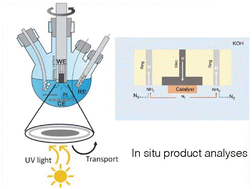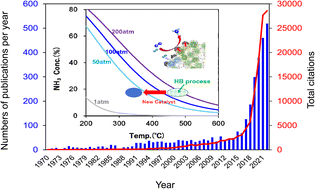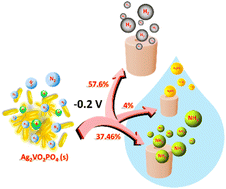Themed collection Sustainable nitrogen activation

List of participants
Faraday Discuss., 2023,243, 575-578
https://doi.org/10.1039/D3FD90017G
Poster list
Faraday Discuss., 2023,243, 571-574
https://doi.org/10.1039/D3FD90018E
Ionic conductivity and disorder in calcium and barium nitrogen hydrogen phases
The performance of the hydride ion conductor Ca2NH is negatively affected by the incorporation of secondary anion sites. BaH2 reacted with N2 at 650 °C producing barium imide which has good electronic properties up to a certain concentration.

Faraday Discuss., 2023,243, 38-54
https://doi.org/10.1039/D2FD00178K
A rotating ring disc electrode study of photo(electro)catalyst for nitrogen fixation
Here, we examine the use of rotating ring disk electrode voltammetry to detect ammonia produced by a nitrogen fixing photo(electro)catalyst. We show that the technique is capable of corroborating bulk measurements but cannot eliminate contamination.

Faraday Discuss., 2023,243, 378-387
https://doi.org/10.1039/D2FD00168C
Concluding remarks: Sustainable nitrogen activation – are we there yet?
In this paper we set out to provide an overview of different approaches to activation of dinitrogen and their commonalities.

Faraday Discuss., 2023,243, 557-570
https://doi.org/10.1039/D3FD00087G
Spiers Memorial Lecture: Catalytic activation of molecular nitrogen for green ammonia synthesis: introduction and current status
This article briefly reviews catalytic activation of N2 for NH3 synthesis under mild conditions. Described are historical background and current demand, recent advances on new catalysts, and next challenges.

Faraday Discuss., 2023,243, 9-26
https://doi.org/10.1039/D3FD00070B
Advancing electrocatalytic nitrogen fixation: insights from molecular systems
A personal perspective summarizing recent progress in studies of electrocatalytic systems capable of mediating the nitrogen reduction reaction.

Faraday Discuss., 2023,243, 450-472
https://doi.org/10.1039/D3FD00017F
Hydrogen ionic conductors and ammonia conversions
Electrochemical and catalytic conversion to and from ammonia is strongly enhanced by appropriate choice of hydrogen conducting electrolyte or substrate. Such materials offer important routes for ammonia conversion and synthesis.

Faraday Discuss., 2023,243, 296-306
https://doi.org/10.1039/D3FD00012E
Electrochemical experiments define potentials associated with binding of substrates and inhibitors to nitrogenase MoFe protein
We associate potentials with the binding of substrates and inhibitors, H+, C2H2, CO and MeNC, to nitrogenase MoFe protein by coupling electrochemical control with gas chromatography analysis and in situ infrared spectroscopy.

Faraday Discuss., 2023,243, 270-286
https://doi.org/10.1039/D2FD00170E
Structural correlations of nitrogenase active sites using nuclear resonance vibrational spectroscopy and QM/MM calculations
57Fe NRVS and QM/MM are paired to identify key spectral components corresponding to the catalytic cofactors of the three nitrogenases.

Faraday Discuss., 2023,243, 253-269
https://doi.org/10.1039/D2FD00174H
Recent advances in plasma-enabled ammonia synthesis: state-of-the-art, challenges, and outlook
Three sustainable plasma-enabled ammonia synthesis routes to zero carbon emissions for chemicals, fertilizers, and biomedical applications coupled with renewable energy.

Faraday Discuss., 2023,243, 473-491
https://doi.org/10.1039/D3FD00006K
Designing mixed-metal electrocatalyst systems for photoelectrochemical dinitrogen activation
We fabricated nitrogen-free, mixed-metal electrocatalyst materials for dinitrogen activation using photoelectrodeposition. First studies indicate the light-assisted reduction of dinitrogen and subsequent protonation with these materials.

Faraday Discuss., 2023,243, 354-377
https://doi.org/10.1039/D2FD00157H
Mechanistic understanding of N2 activation: a comparison of unsupported and supported Ru catalysts
Our density functional theory calculations reveals a N2 activation mechanism that explains the different dissociation barriers of N2 on models of unsupported Ru(0001) terraces, Ru B5 sites, and polar MgO(111)-supported Ru B5 homologues.

Faraday Discuss., 2023,243, 148-163
https://doi.org/10.1039/D2FD00172A
Switching on/off molybdenum nitride catalytic activity in ammonia synthesis through modulating metal–support interaction
An elegant approach to finely tune the structural, physico-chemical, redox and electronic properties of the active site by modulating the interaction between Mo nanoparticles and their support.

Faraday Discuss., 2023,243, 126-147
https://doi.org/10.1039/D2FD00154C
A conformational equilibrium in the nitrogenase MoFe protein with an α-V70I amino acid substitution illuminates the mechanism of H2 formation
The reactivity of Fe-hydrides at the nitrogenase active-site cofactor is revealed by studies of the α-V70I substituted protein.

Faraday Discuss., 2023,243, 231-252
https://doi.org/10.1039/D2FD00153E
Metal-loaded zeolites in ammonia decomposition catalysis
This study focuses on characterising and optimising novel zeolite-supported Ru catalysts for ammonia decomposition, with a focus on the effects of N-substitution on catalyst structure and activity.

Faraday Discuss., 2023,243, 520-548
https://doi.org/10.1039/D2FD00175F
Electrochemical nitrogen reduction reaction over gallium – a computational and experimental study
This work explores the electrocatalytic activity of Ga which was identified earlier as one of the “overlooked” metals for catalyzing the electrochemical nitrogen reduction reaction (ENRR).

Faraday Discuss., 2023,243, 307-320
https://doi.org/10.1039/D2FD00169A
In search of the bottlenecks of ammonia synthesis over Ru/Vulcan under ambient conditions
Interactions between atomic hydrogen and dinitrogen are facile under ambient conditions. N–NH3 is the best candidate estimated by DFT corroborating the experimental IR shift. Desorption of NH3 limits the rates under subcritical conditions.

Faraday Discuss., 2023,243, 164-178
https://doi.org/10.1039/D2FD00173J
Structural evolution of TiN catalysts during mechanocatalytic ammonia synthesis
During milling in N2 and H2, Ti metal is converted into TiN. Once formed, TiN acts as a mechanocatalyst for ammonia formation. The evolution of the structure and reactivity of the TiN catalyst with milling time are discussed.

Faraday Discuss., 2023,243, 65-76
https://doi.org/10.1039/D2FD00164K
Catalytic reduction of dinitrogen to ammonia using molybdenum porphyrin complexes
N2 reduction to ammonia is catalyzed by molybdenum complexes of a bulky porphyrin, and the thermodynamics of the first PCET step are evaluated.

Faraday Discuss., 2023,243, 429-449
https://doi.org/10.1039/D2FD00166G
N2 solar activation: ammonia as a hydrogen vector for energy storage
In this work, various types of layered double hydroxides were evaluated as novel catalysts for photo-assisted dinitrogen fixation.

Faraday Discuss., 2023,243, 388-401
https://doi.org/10.1039/D2FD00147K
Why copper catalyzes electrochemical reduction of nitrate to ammonia
The activity volcano plot depicts trends in activity among various transition metals and explains why copper is more active for the nitrate reduction reaction (NO3RR) to ammonia. Several strategies are proposed to further improve copper activity.

Faraday Discuss., 2023,243, 502-519
https://doi.org/10.1039/D2FD00145D
Sustainable ammonia synthesis through electrochemical dinitrogen activation using an Ag2VO2PO4 catalyst
An Ag2VO2PO4 catalyst synthesized via sonochemical route exhibits a nano rice-grain like morphology and presents electrochemical N2 activation at −0.2 V with a high NH3 yield rate of 1.48 mg h−1 mgcat.−1 and a F.E. of 37.46% in alkaline solution.

Faraday Discuss., 2023,243, 339-353
https://doi.org/10.1039/D2FD00150K
The formation of a lithium–iridium complex hydride toward ammonia synthesis
Ir, generally considered inactive for nitrogen fixation, can catalyze ammonia formation at much enhanced reaction rates by compositing with LiH.

Faraday Discuss., 2023,243, 55-64
https://doi.org/10.1039/D2FD00142J
Barium hydride activates Ni for ammonia synthesis catalysis
Barium hydride activates Ni for ammonia synthesis catalysis showing an activity that is comparable to that of the Cs promoted MgO supported Ru catalyst.

Faraday Discuss., 2023,243, 27-37
https://doi.org/10.1039/D2FD00143H
The origin of overpotential in lithium-mediated nitrogen reduction
We present a simple method for determining the reversible hydrogen electrode potential in a lithium-mediated nitrogen reduction system, and use this to highlight that the greatest source of cathodic potential loss is the requirement for in situ lithium plating.

Faraday Discuss., 2023,243, 321-338
https://doi.org/10.1039/D2FD00156J
Low temperature ammonia synthesis by surface protonics over metal supported catalysts
Low-temperature ammonia synthesis by applying an electric field to a solid heterogeneous catalyst was investigated to realize an on-demand, on-site catalytic process for converting distributed renewable energy into ammonia.

Faraday Discuss., 2023,243, 179-197
https://doi.org/10.1039/D2FD00146B
Experimental and theoretical investigations on the anti-perovskite nitrides Co3CuN, Ni3CuN and Co3MoN for ammonia synthesis
Potential of the anti-perovskite nitrides as reagents for the production of ammonia through chemical looping.

Faraday Discuss., 2023,243, 97-125
https://doi.org/10.1039/D2FD00151A
Mechanism of ammonia synthesis on Fe3Mo3N
The novel Eley–Rideal–Mars–van-Krevelen mechanism for ammonia synthesis on Fe3Mo3N relies on the presence of surface lattice N vacancies and proceeds through the  intermediate.
intermediate.

Faraday Discuss., 2023,243, 77-96
https://doi.org/10.1039/D2FD00148A
Electrocatalytic and photocatalytic routes to N2 activation: general discussion
Faraday Discuss., 2023,243, 402-428
https://doi.org/10.1039/D3FD90007J
Alternative routes to NH3 and its application: general discussion
Faraday Discuss., 2023,243, 549-556
https://doi.org/10.1039/D3FD90009F
Heterogeneous catalytic and chemical looping routes to N2 activation: general discussion
Faraday Discuss., 2023,243, 198-230
https://doi.org/10.1039/D3FD90010J
Enzymatic N2 activation: general discussion
Faraday Discuss., 2023,243, 287-295
https://doi.org/10.1039/D3FD90011H
Homogeneous N2 activation: general discussion
Faraday Discuss., 2023,243, 492-501
https://doi.org/10.1039/D3FD90008H
About this collection
We are delighted to share with you a selection of the papers associated with a Faraday Discussion on Sustainable nitrogen activation. More information about the related event may be found here: http://rsc.li/nitrogen-fd2023. Additional articles will be added to the collection as they are published. The final versions of all the articles presented and a record of the discussions will be published after the event.
This Discussion will focus on the development of more sustainable routes to ammonia production. Industrial scale ammonia synthesis, as accomplished by the Haber Bosch Process, was a landmark achievement of the 20th Century. However, as currently practiced, including feedstock generation, the process accounts for 1-2% of global energy demand and contributes significant fossil fuel-based CO2 emissions. Accordingly, there is much interest in the development of more sustainable ammonia synthesis routes.
Contributions will cover Heterogeneous catalytic and chemical looping routes to N2 activation, Electrocatalytic and photocatalytic routes to N2 activation, Enzymatic N2 activation and Homogeneous N2 activation. On behalf of the Scientific Committee, we hope you join us and participate in this exciting event, and that you enjoy these articles and the record of the discussion.